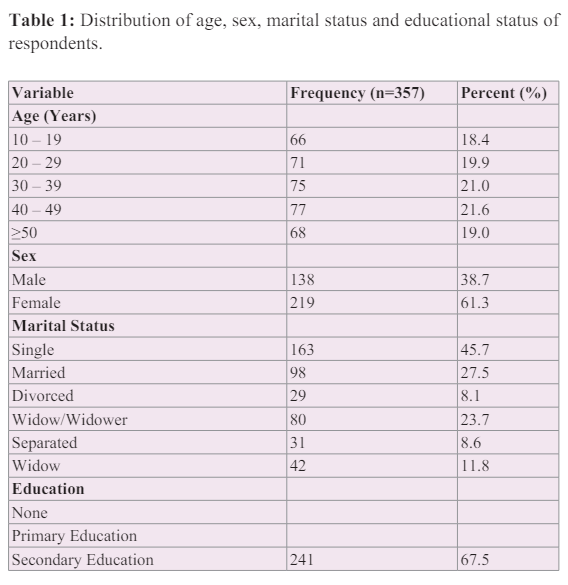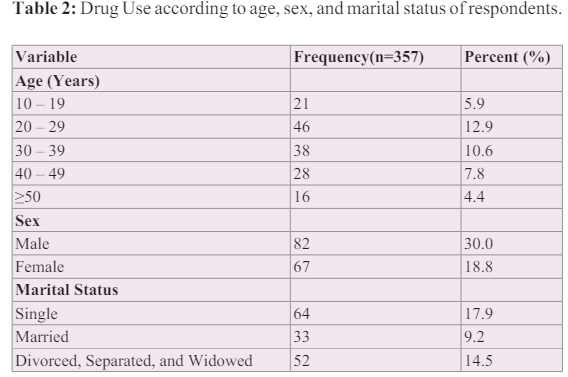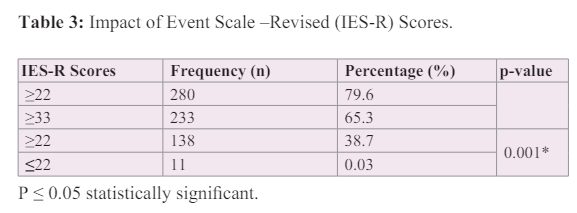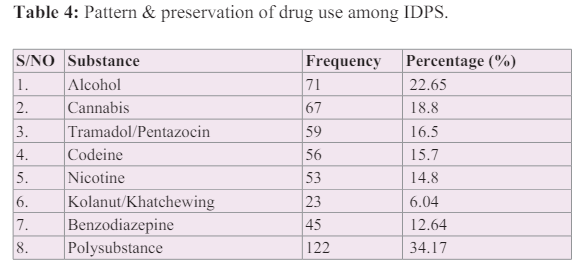Impact of Traumatic Events on Substance Use among Internally Displaced People in Selected Flood and War Impacted Areas in Rivers State
Author'(s): Nkporbu A.K.1*, Oti I.K2 and Stanley P.C1
1Department of Neuropsychiatry, University of Port Harcourt Teaching Hospital, Nigeria.
2Department of Physiotherapy, University of Port Harcourt Teaching Hospital.
*Correspondence:
NKPORBU A.K. (MB, BS, MSc Pharmcol, MPH, FWACP, ICAP,Ph.D), Department of Neuropsychiatry, University of Port Harcourt Teaching Hospital, Nigeria
Received:29 Dec 2022; Accepted:Accepted: 02 Jan 2023; Published: 17 Jan 2023
Citation: Nkporbu AK, Oti IK, Stanley PC. Impact of Traumatic Events on Substance Use among Internally Displaced People in Selected Flood and War Impacted Areas in Rivers State. Addict Res. 2023; 7(1): 1-4.
Abstract
Background: Different individuals react differently to emotionally traumatic events just as there are varying degrees of coping mechanisms. One of the common maladaptive coping mechanisms of victims of internal displacement is increased predisposition to substance use.
Aim: This study determined the relationship between stressful life events and substance use among victims of flood and wars in selected parts of Rivers State.
Methods: A cross-sectional study was conducted in 4 different flood and war impacted areas where 357 respondents were investigated. Ethical procedures were followed including consent from participants. Respondents of between the ages 10-75 years were included in the study and their socio-demographic characteristics determined. The Impact of Event Scale –Revised (IES-R) was used to assess posttraumatic symptomatology of the flood victims, while the CAGE and a semi-structured questionnaire were used to assess alcohol and other psychoactive substances. Rapid urine drug toxicology was done for the respondents. Data was analysed using the SPSS version 20. p≤0.05 was considered statistically significant.
Results: Two hundred and eighty (79.6%) respondents had IES-R score of 22 and above while 65.3% (n=233) scored 33 and above. Prevalence of substance use was 34.4% (n=123) from self-report and 41.7% (n=149) from urine toxicology. Of the 149 respondents, 138 was among those who scored IES-R 22 and above while 11 was among those who scored below 22 (p=0.001). Alcohol was the most consumed drug with 22.65 (n=81), followed by cannabis with 18.8% (n=67), tramadol 16.5% (n=59), codeine 15.7% (n=56), Nicotine 14.8% (n=53), kolanut and khatchewing 6.4% (n=23), and benzodiazepam 12.8% (n=64). Polysubstance use was 34.17% (n=122). Three respondents use drug intravenously. Substance use significantly correlated with IES-R scores (p=0.002).
Conclusion: Stressful and traumatic events may increase vulnerability to substance use, therefore Internally Displaced People (IDP) may require substance use disorder services and psychological care.
Keywords
Introduction
Mass displacement of individuals and the community at large often because of conflicts and natural disasters is a common occurrence in our society and can be due to ethnic, religious, political or economic reasons [1]. These displaced individuals can be exposed to a high number of traumatic events and may eventually experience post-traumatic stress disorder [2]. Internally Displaced Persons (IDPs) have been described by [3] as “persons or groups of people who have been forced to leave or left their homes or places of habitual residence as a result of or in order to avoid the effects of armed conflicts, situations of generalized violence, violations of human rights or natural or human-made disasters”. According to [4] WHO 2016, more than 40 million people were displaced in 2015 because of wars and violence caused by religious and ethnic conflicts, whereas 19.2 million were displaced by natural disasters such as famine and floods. 12 million people were displaced in Africa by violence with hundreds of thousands of people being displaced by natural disasters [5]. About 5.2 million people have been victims of internal displacement annually in Middle East and Sub-Saharan African countries for more than 10 years, and this is usually as a result of insurgency, terrorism, and political instability [6]. About 75% of these IDPs are found in ten countries of the world, and five of these are located in Sub-Sahara Africa [7,8].
Studies have shown that substance use may be a coping mechanism for survival among several internally displaced individuals [9]. Substance use among internally displaced persons appears to be a neglected subject of discuss in public health and as such deserves due attention [10]. Substance use is a major cause of ill-health globally, and alcohol related mortality alone accounts for 4% of all deaths [10]. The use of substances among the IDPs is linked with a number of mental health problems including depression [11]. Growing interests in the mental health of populations of internally displaced individuals in recent years have focused more on post- traumatic stress disorder and depression among these individuals [12-14].
Internal displacement of persons has significant effects on the health and well-being of the affected individuals and on public health in general [15]. These effects can be highly impactful and may be grouped as direct and indirect impacts [16]. Direct impacts include those due to violence and the accompanying injury while indirect impacts are those resulting from infectious diseases and malnutrition [17,18]. Malnutrition has been reported among under- five children in Sub-Sahara Africa 19]. According to [19], “the spectrum of malnutrition includes stunting (38.6%), underweight (28.4%), and wasting (7.2%). Despite these large numbers of internally displaced persons (IDPs) in Sub-Saharan African countries and the potentially negative impact of displacement on the health of these populations, there is limited information on the substance use problems of IDPs in the region. Nigeria is one of the Sub-Saharan African countries. Therefore, this study was aimed at determining the relationship between stressful life events and substance use among victims of flood and wars in selected parts of Rivers State, Nigeria.
Materials and Methods
This was a cross-sectional study conducted in four (4) different flood and war impacted areas of Rivers State where 357 respondents were investigated. Sampling technique employed was systematic random sampling, which was based on convenience. Rivers State (also known as Rivers) is one of the states in the Niger Delta region of the Southern Nigeria. It has a total of 23 Local Government Areas. Five IDP Camps in Rivers State were selected (1 due to war, and 4 due to flood). Rivers State is in the Southern part of Nigeria (South-South). It is the main hub of oil and gas of Nigeria. It is the most multi-ethnic State in Nigeria and has the highest annual rainfalls. There is average of 300 persons in each IDP Camp in the State; all within the Local Government of the affected areas. Ethical procedures were followed including consent from participants. Respondents of between ages 10-70 years were included in the study (UNODC global statistic of highest drug prevalence among 15-65 years). Structured socio-demographic questionnaire and The Impact of Event Scale -Revised (IES-R) were used in the study. IES-R is a 22-Item self-report scale that measures subjective distress cause by traumatic event and assesses post traumatic symptomatology. The IES-R was developed in 1997 by Daniel Weiss and Charles Marmar to reflect the DSM-IV criteria for post-traumatic stress disorder (PTSD). The original Impact of Events Scale (IES) predated the adoption of PTSD as a ‘legitimate’ diagnosis in the DSM-III of 1980 and measured two of the four DSM-IV criteria for PTSD. The main strength of this revised measure is that it is short, quick and easy to administer, and score and may be used repeatedly to assess progress. The ASSIST was used to assess alcohol and other psychoactive substances. Data was analysed using the SPSS version 20.
Results
Table 1 revealed that majority of the respondents was females 219 (61.3%) between the age bracket of 40-49 with the proportion of 77 (21.6%). Majority were single 163 (45.7%) while the least were divorced 29 (8.1%). On educational level, the total number of persons with no education, primary and secondary education was 241 (67.5%).


The results in table 2 revealed that majority of the drug users were male 82 (30.0%), and were within the age range 20-29 with a proportion of 46(12.9%). Majority of the users were single 64 (17.9%).

Two hundred and eighty (79.6%) respondents had IES-R score of 22 and above while 65.3% (n=233) scored 33 and above. Prevalence of substance use was 41.7% (n=149). Of the 149 respondents, 138(38.7%) were among those who scored IES-R 22 and above while 11 (0.03%) were among those who scored below 22 (p=0.001).

Alcohol was the most consumed drug with 22.65 (n=71), followed by cannabis with 18.8% (n=67), tramadol 16.5% (n=59), codeine 15.7% (n=56), Nicotine 14.8% (n=53), kolanut and khatchewing 6.4% (n=23), and benzodiazepam 12.8% (n=64). Polysubstance use was 34.17% (n=122). Three respondents use drug intravenously. Current users= 126 (84.6%). Seventy six (51.0%) Respondents started using substances during displacement (p=0.001). Substance use significantly correlated with IES-R scores. (p=0.002).
Discussion
This study determined the relationship between stressful life events and substance use among victims of flood and wars in selected parts of Rivers State. It revealed that majority of the flood victims were females 219 (61.3%) between the age bracket of 40-49 with the frequency/percentage of 77 (21.6%). In addition, majority were single 163 (45.7%) while the least were divorced 29 (8.1%). This finding is consistent with the finding of [20] in which majority of the respondents were females but slightly differ in their age brackets. The study by [20] was conducted in Uganda east-Africa while that the present study was conducted in Nigeria, a west- African country. The present study also revealed that majority of the drug users were male 82 (30.0%), within the age range 20- 29 and single. This is consistent with previous studies [21-23]. A possible explanation of this difference in the use of drug between males and females is that males are usually more adventurous than their female counterparts. Young singles usually within the age bracket of 20-29 are also generally more adventurous and like to experiment on different substances more than their married, widowed or divorced counterparts. The implication of this finding is that young men/women are exposed to substance use early leading to several traumatic conditions in the future.
Furthermore, the study found out that among the flood victims, the greater number of the respondents had IES-R score of 22 and above, and that substance use significantly correlated with IES-R scores (p=0.002). This result slightly differs from the findings of [24-26]. In the same vein, the result in which Alcohol was the most consumed drug with 22.65 (n=71), followed by cannabis with 18.8% (n=67) etc. is similar to the finding of [22] which investigated the pattern of substance use among patients attending the drug unit of the University of Port Harcourt Teaching Hospital (UPTH). The similarity seen in both studies could be as a result of fact that they were conducted in similar settings (within Rivers State, Nigeria) with similar socio-demographic characteristics.
Studies have found relationship between drug abuse and global terrorism, insecurity and victims of natural disasters [8,11]. Displacement due to insecurity or natural occurrences can be held to be immediately responsible for the upsurge in drug abuse and addiction when they occur [8,11]. Psychoactive substances are widely available and some of them, very cheap and easy to procure. Even when some of the illicit drugs are not readily available and affordable, some victims of wars and floods resort to inhaling gum and drinking alcohol or cough syrups. Most of them attempts to take drugs to help relieve the trauma visited on them by the disaster.
The fact that these individuals are forced out of their natural environments and comfort zones can predispose them to a number of psychological, social and physical problems [12]. Many of them are still caught in the trauma of losing loved ones, entire families or valuable in the most harrowing circumstances or either war or flood. Apart from food, medicines, shelter, clothing and a generally conducive environment, most of these IDPs, especially those who have become addicted to drugs, need drug addiction and trauma experts to help them manage their huge burdens.
Conclusion
Stressful and traumatic events increase vulnerability to substance use. Therefore, Internally Displaced Persons (IDPs) require substance use treatment, prevention services, and psychological care.
References
1. Kett M. Displaced populations and long-term humanitarianassistance. BMJ. 2005; 331: 98-100.
2. Porter M, Haslam N. Predisplacement and postdisplacement factors associated with mental health of refugees and internally displaced persons: A meta-analysis. Journal of the American Medical Association. 2005; 294: 602-612.
3. United Nations Commission on Human Rights. Report of the Representative of the Secretary-General on Internally Displaced Persons: Guiding Principles on Internal Displacement. 1998; 2.
4. World Health Organization. 2016.
5. Owoaje ET, Uchendu OC, Ajayi TO, et al. A review of the health problems of the internally displaced persons in Africa. Niger Postgrad Med J. 2016; 23: 161-171.
6. Norwegian Refugee Council. IDMC. Global Report on Internal displacement. 2016; 8-13.
7. Norwegian Refugee Council. IDMC. Global Report on Internal displacement. 2016; 8-13.
8. Norwegian Refugee Council. IDMC. Global Overview 2015, People Internally Displaced by Conflict and Violence. 2015; 210-239.
9. Usoro NA, Okediji EA, Udoh EA, et al. Prevalence of drug use among internally displaced persons in Akwa Ibom State Nigeria. AND SOCIETY IN AFRICA. 2017; 4: 11.
10. Rehm J, Mathers C, Popova S, et al. Global burden of disease and injury and economic cost attributable to alcohol use and alcohol-use disorders. Lancet. 2009; 373: 2223-2233.
11. Room R, Babor T, Rehm J. Alcohol and public health. Lancet. 2005; 365: 519-530.
12. Scholte WF, Olff M, Ventevogel P, et al. Mental Health Symptoms Following War and Repression in Eastern Afghanistan. JAMA. 2004; 292: 585-593.
13. Cardozo BL, Bilukha OO, Crawford CAG, et al. Mental Health Social Functioning and Disability in Postwar Afghanistan. JAMA. 2004; 292: 575-584.
14. De Jong JTVM, Komproe IH, Van Ommeren M, et al. Lifetime Events and Posttraumatic Stress Disorder in 4 Postconflict Settings. JAMA. 2001; 286: 555-562.
15. The Sphere Handbook. Minimum standards in health action. In The Sphere Project: Humanitarian Charter and Minimum Standards in Disaster Response. 2011; 287-354.
16. Olwedo MA, Mworozi E, Bachou H, et al. Factors associated with malnutrition among children in internally displaced person′s camps Northern Uganda. Afr Health Sci. 2008; 8: 244-252.
17. Guerrier G, Zounoun M, Delarosa O, et al. Malnutrition and mortality patterns among internally displaced and non- displaced population living in a camp a village or a town in Eastern Chad. PLoS One. 2009; 4: e8077.
18. Lam E, McCarthy A, Brennan M. Vaccine-preventable diseases in humanitarian emergencies among refugee and internally-displaced populations. Hum Vaccin Immunother. 2015; 11: 2627-2636.
19. Turnip SS, Klungsøyr O, Hauff E. The mental health of populations directly and indirectly exposed to violent conflict in Indonesia. Confl Health. 2010; 4: 14.
20. Roberts B, Ocaka KF, Browne J, et al. Alcohol disorder amongst forcibly displaced persons in northern Uganda. Addictive behaviors. 2011; 36: 870-873.
21. Gupta S, Sarpal SS, Kumar D, et al. Prevalence pattern and familial effects of substance use among the male college students a north Indian study. J Clin Diagn Res. 2013; 7: 1632-1636.
22. Nkporbu AK, Oti IK, Metu I. Pattern of Substance Use among Patients Attending the Drug Unit of the University of Port Harcourt Teaching Hospital. J Biomed Res Environ Sci. 2022; 3: 215-220.
23. Adamson TA, Ogunlesi AO, Morakinyo O, et al. Descriptive national survey of substance use in Nigeria. J Addict Res Ther. 2015; 6: 234.
24. Beck JG, Grant DM, Read JP, et al. The impact of event scale- revised psychometric properties in a sample of motor vehicle accident survivors. Journal of anxiety disorders. 2008; 22: 187-198.
25. Feuerherd M, Knuth D, Muehlan H, et al. Differential item functioning analyses of the Impact of Event Scale-Revised: Results from a large European study on people with disaster experiences. Traumatology. 2014; 20: 313.
26. Soroush A, Ziapour A, Abbas J, et al. Effects of group logotherapy training on self-esteem communication skills and impact of event scale-revised in older adults. Ageing International. 2022; 47: 758-778.